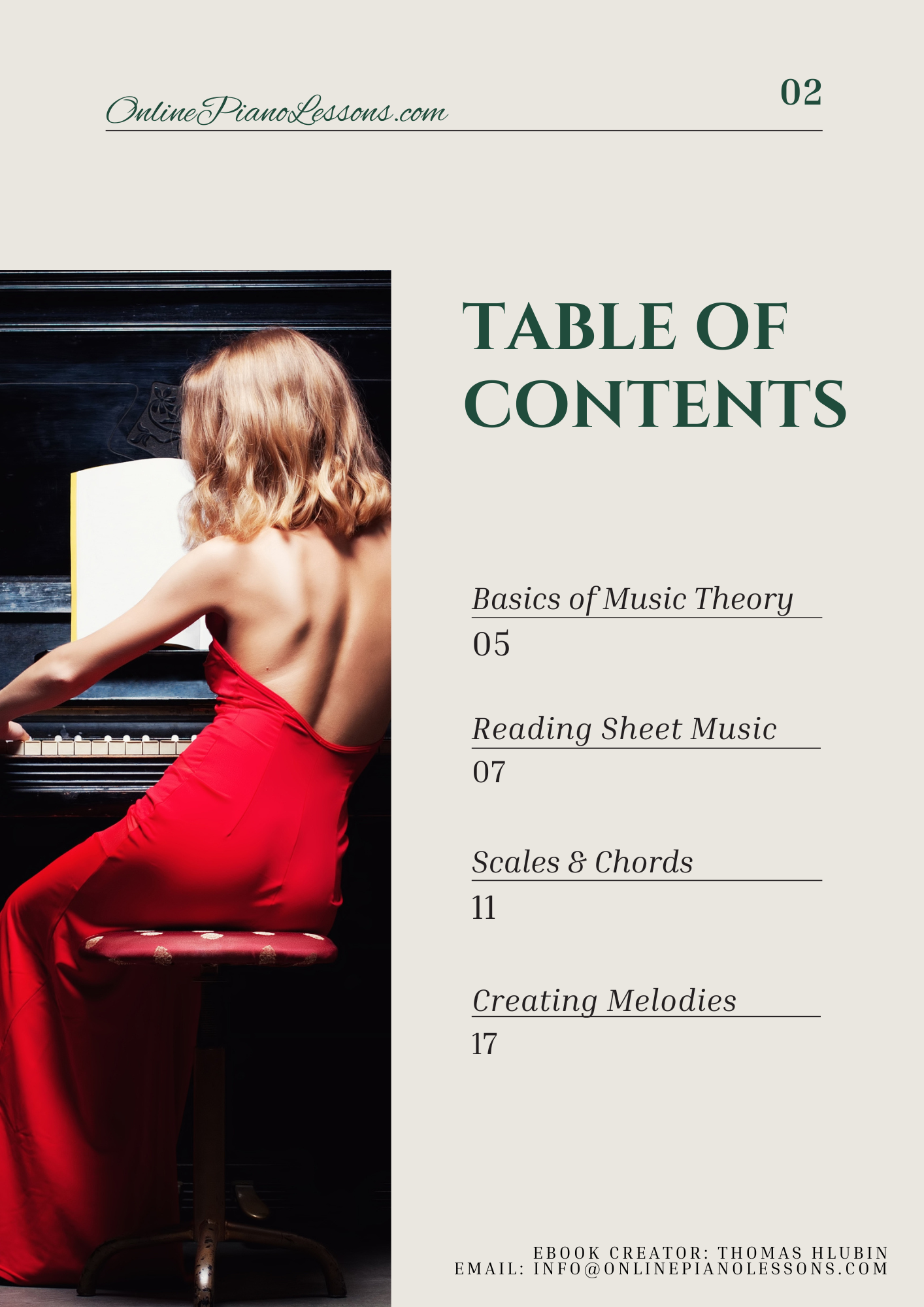The octatonic scale is one of the most fascinating and mysterious sounds in music. Often associated with jazz, classical, and film scores, this unique eight-note scale creates a sense of tension, symmetry, and unpredictability that has captured the imagination of composers and pianists for over a century.
In this guide, we’ll explore what the octatonic scale is, how it works on the piano, how to build it, and why it’s so important in modern music. By the end, you’ll understand not only how to play octatonic scales but also how to use them creatively in your own music.
What Is an Octatonic Scale?
The term octatonic literally means “eight tones.” Unlike the traditional seven-note major or minor scales, an octatonic scale contains eight unique notes before it repeats at the octave.
What makes it special is its perfectly symmetrical structure. The notes alternate between whole steps and half steps in an even, repeating pattern. This pattern gives the octatonic scale its distinctive, almost otherworldly sound.
For example, one common form of the octatonic scale starts on C and follows this pattern:
C – D – D♯ – F – F♯ – G♯ – A – B – C
Notice the alternating steps: whole, half, whole, half, and so on. This precise symmetry means the octatonic scale doesn’t strongly pull toward a single tonal center, which is why it’s often used to create ambiguity and tension in music.
The Two Main Types of Octatonic Scales
There are two types of octatonic scales used in Western music. Each type alternates steps differently:
-
Half-Whole Octatonic Scale
This version begins with a half step followed by a whole step, and continues alternating.
Example on C: C – D♭ – E♭ – E – F♯ – G – A – B♭ – CThis is sometimes called the “dominant diminished scale” because it fits perfectly over dominant seventh chords with flat ninths (like C7♭9).
-
Whole-Half Octatonic Scale
This version starts with a whole step, then a half step, and alternates from there.
Example on C: C – D – E♭ – F – F♯ – G♯ – A – B – CThis one is often used with diminished seventh chords and is sometimes referred to as the “diminished scale.”
Both of these octatonic scales have eight tones and are built symmetrically. The only difference is where you start in the whole-step/half-step pattern.
What Do Octatonic Scales Sound Like?
The octatonic scale has a mysterious, haunting quality that can sound both modern and ancient at the same time. On the piano, it feels harmonically rich and unstable, making it a favorite in film music and jazz improvisation.
Because of its symmetry, the octatonic scale lacks a clear tonal center, which creates tension and suspense. Composers like Igor Stravinsky, Béla Bartók, and Claude Debussy often used octatonic scales to add dissonance and drama to their works.
In jazz, legends such as John Coltrane and Thelonious Monk used octatonic scales to create fast-moving lines and harmonically complex solos.
When you play it on the piano, it might remind you of movie scores, mysterious passages, or even the music used in suspenseful video games. It’s a scale full of color and emotion—perfect for experimenting and expanding your musical vocabulary.
How to Build an Octatonic Scale on the Piano
Learning to build an octatonic scale on the piano is straightforward once you understand the pattern. Follow these steps:
-
Choose your starting note. Let’s start on C for simplicity.
-
Decide which version to build. You’ll choose either the whole-half or half-whole version.
-
Apply the pattern.
-
For the whole-half version: Whole, Half, Whole, Half, etc.
-
For the half-whole version: Half, Whole, Half, Whole, etc.
-
Example 1: C Whole-Half Octatonic Scale
C – D – E♭ – F – F♯ – G♯ – A – B – C
Example 2: C Half-Whole Octatonic Scale
C – D♭ – E♭ – E – F♯ – G – A – B♭ – C
You can move this pattern starting from any note on the piano to get all 12 possible octatonic scales.
Why Octatonic Scales Are Important
The octatonic scale holds a special place in both classical and modern music theory. Here’s why it’s so important for pianists and composers:
- Symmetry and Balance
Because of its consistent pattern, the octatonic scale divides the octave evenly. This gives it a unique, balanced structure that can inspire innovative harmonic progressions. - Harmonic Richness
The scale contains multiple major, minor, diminished, and dominant chords within its notes. This means you can create a variety of harmonic colors just from one scale. - Versatility
The octatonic scale can be used in jazz improvisation, classical composition, film scoring, and even rock or electronic music. - Creative Expression
Its unusual sound helps musicians break free from the predictable patterns of major and minor scales, offering fresh melodic and harmonic possibilities on the piano. - Historical Significance
From Rimsky-Korsakov to Miles Davis, countless great artists have used octatonic scales to push the boundaries of their genres.
How to Practice Octatonic Scales on the Piano
If you’re new to the octatonic scale, start by practicing hands separately, focusing on evenness and finger control. Because of its alternating step pattern, the fingerings can feel unusual at first.
Try these practice ideas:
- Play the scale in parallel motion. Start slowly, one octave up and down.
- Use contrary motion. Play the same octatonic scale starting from both hands but moving in opposite directions.
- Improvise short melodies. Create mysterious or jazzy phrases to get used to the sound.
- Play over diminished chords. Experiment with the half-whole version over dominant chords to explore jazz harmony.
As you gain comfort, integrate octatonic scales into your warm-ups, improvisations, and compositions. Over time, your ear will start recognizing their distinct flavor.
Using Octatonic Scales in Music
The real power of the octatonic scale comes when you use it creatively. On the piano, it can serve as a bridge between keys, a source for complex harmonies, or a tool for improvisation.
- In Classical Music: Composers like Stravinsky used octatonic scales to evoke tension and exoticism.
- In Jazz: Pianists use them over dominant seventh or diminished chords to add spice to solos.
- In Film Music: Sound designers rely on octatonic scales to create eerie, suspenseful atmospheres.
- In Composition: The symmetrical nature allows for smooth modulation between keys and endless variation.
No matter your style, understanding octatonic scales gives you a deeper appreciation for how tension, release, and color work in music.
Common Octatonic Scales on the Piano
Here are some commonly used octatonic scales you can practice on the piano:
- C Octatonic (Whole-Half): C – D – E♭ – F – F♯ – G♯ – A – B – C
- C♯/D♭ Octatonic: C♯ – D♯ – E – F♯ – G – A – B♭ – C – C♯
- D Octatonic: D – E – F – G – G♯ – A♯ – B – C♯ – D
- E♭ Octatonic: E♭ – F – F♯ – G♯ – A – B – C – D – E♭
- E Octatonic: E – F♯ – G – A – A♯ – C – C♯ – D♯ – E
- F Octatonic: F – G – A♭ – A – B – C♯ – D – E – F
Each version produces slightly different colors, so experiment with them to find which feels most expressive to you.
Conclusion
The octatonic scale is one of the most versatile and intriguing tools you can add to your piano playing. Its symmetrical design, rich harmonic potential, and mysterious sound make it a favorite among musicians seeking new creative directions.
Whether you’re exploring jazz improvisation, classical harmony, or cinematic composition, mastering octatonic scales will open up a new world of musical possibilities. It’s a reminder that sometimes the most beautiful sounds come from breaking traditional boundaries.
FAQ
Why is it called an octatonic scale?
Because it contains eight distinct notes per octave instead of the usual seven found in major and minor scales.
What is the difference between the half-whole and whole-half octatonic scales?
The difference lies in the order of intervals. One starts with a half step and the other with a whole step, creating two distinct but related patterns.
How do I use octatonic scales in jazz?
Jazz pianists often use the half-whole octatonic scale over dominant chords to create tension before resolving to a tonic chord.
Are octatonic scales hard to play on the piano?
They may feel awkward at first because of their alternating step pattern, but with consistent practice, they become fluid and intuitive.
Which famous composers used octatonic scales?
Igor Stravinsky, Claude Debussy, Béla Bartók, and many modern jazz musicians, including John Coltrane, have used octatonic scales extensively in their work.







 Hi, I'm Thomas, Pianist Composer,
Hi, I'm Thomas, Pianist Composer,  I love playing piano, creating new melodies and songs, and further developing my online piano course and making updates/additions to my site OnlinePianoLessons.com!
I love playing piano, creating new melodies and songs, and further developing my online piano course and making updates/additions to my site OnlinePianoLessons.com!  Now that is what I call fun!
Now that is what I call fun!
